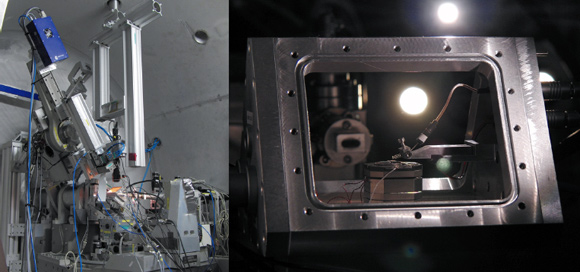- Home
- Users & Science
- Scientific Documentation
- ESRF Highlights
- ESRF Highlights 2009
- Facts and Figures
- Commercial activities at the ESRF
Commercial activities at the ESRF
The ESRF’s prime mission is an academic one: providing state-of-the-art X-ray facilities for university- and institute-based researchers. However, the requirements of industry are also an important ingredient of our missions, highlighted by the ESRF Convention signed in 1988 which accurately predicted that “synchrotron radiation will in the future be of great significance in many different fields and for industrial applications”.
The proof of the pudding is in the eating, and since the start of ESRF operation in 1994, industrial applications of synchrotron radiation have grown enormously and now cover fields from pharmaceuticals, automotive engineering to metallurgy, cosmetics, food and mining, to name but a few. A key advantage for industry is to be able to study real systems under real operating conditions. Industrially generated income equated to 2.9% of the ESRF’s budget for 2008, with the lion’s share being generated through beam time sales, and the remainder through service and material sales (mostly to other synchrotrons), and licensing income. The income is used to support around 16 staff positions (the majority for ESRF user support and operations) and reinjected into the ESRF facilities.
The ESRF deploys an Industrial and Commercial Unit (ICU) which is dedicated to relations with industry and contract management. Together with four industrial engineers (three for macromolecular crystallography and one for X-ray imaging), the ICU is the principle means of generating additional resources for the budget.
Over the last two years, the ICU interviewed all of our main industrial clients, mostly face-to-face, for their feedback on the ESRF industrial experience. The main positive points to emerge were the quality of the data, our scientific expertise, the speed of data acquisition and the quality of the beamlines themselves as well as our flexibility and responsiveness to client’s requests. Areas for improvement included full overnight support and some compatibility problems with software on the beamlines. Points on a more practical level concerned the ICU web pages, which have recently been reworked. Feedback is always welcome at any time so we can improve the ESRF industrial experience.
During 2008 and 2009, the first spin-off from the ESRF, Small-Infinity (www.smallinfinity.com), went through the initial stages of creation, making good use of funding and advice from the Grenoble-based GRAIN and GRAVIT innovation incubators to help its development stages. Small-Infinity is founded on the commercialisation of the first atomic-force microscope that can operate directly on X-ray beamlines and is also now developing a cooled-mode device that has strong potential, particularly for biological applications. The cooling-mode technology has evolved out of the EU FP6-funded project “X-TIP” on nanoscale chemical mapping and surface structural modification by the combined use of X-ray microbeams and tip-assisted local detection. The ESRF has devices installed on beamline ID01 (Figure 167), already enabling exciting science, with further devices to arrive soon.
 |
|
Fig. 167: A Small-Infinity atomic-force microscope installed on ID01 (Images courtesy: T. Scheler). |
As mentioned above, the principal component of ESRF industrial income is from the sale of beam time, mainly to the pharmaceutical industry. Pharmaceutical companies use macromolecular crystallography (MX) as a core technique in drug discovery to provide detailed 3D structural information on their protein targets and binding of drug candidates and fragments. Since 2002 the ESRF has operated the MXpress™ service where clients send samples by courier for data collection on the MX beamlines. The MXpress service adds substantial value for the clients who obtain the best data possible from their samples through the experience and know-how of ESRF scientists who have handled thousands of samples. It is important to note that the development and needs of the MXpress service have provided, and continue to provide, considerable added value to the ESRF generally: automation, reliability and software improvements have all been partially driven and directed by the requirements of such an activity. Other significant contributors to the beam time income are the X-ray imaging beamlines (particularly ID19), the small-angle X-ray scattering beamline ID02, EXAFS on ID24 and powder diffraction on ID31. Samples for imaging scans and powder diffraction are often sent by courier to the ESRF, as for MXpress, for experiments to be performed by ESRF scientific staff.
Looking to the future, industrial activities will remain a useful component of the ESRF, having a strong and visible economic impact as well as providing a useful income. The new Instrumentation Services and Development Division will provide a pivotal critical mass to create long-term relationships with industry for collaborative developments, likely to lead to more transfer to industry of the ESRF’s innovative technologies. When the economic climate changes for the better, the ESRF will be in a strong position to broaden its relationships and networks with industry in Europe and worldwide.
For further information on the ESRF commercial programme, proprietary beam time and opportunities, please contact us.
E. Mitchell



